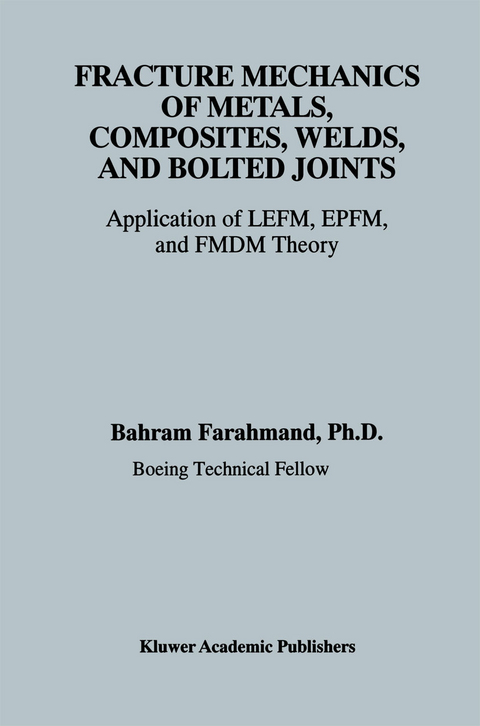
Fracture Mechanics of Metals, Composites, Welds, and Bolted Joints
Kluwer Academic Publishers (Verlag)
9780792372394 (ISBN)
Chapter1 Overview of Fracture Mechanics and Failure Prevention.- 1.0 Introduction.- 1.1 High Cycle Fatigue.- 1.2 Low Cycle Fatigue.- 1.3 Stress and Strain at Notch (Neuber Relationship).- 1.4 Linear Elastic Fracture Mechanics (LEFM) and Applications.- 1.5 Elastic-Plastic Fracture Mechanics (EPFM).- 1.6 Failure Prevention and Fracture Control Plan.- References.- Chapter2 Linear Elastic Fracture Mechanics (LEFM) and Applications.- 2.0 Introduction to Elastic Fracture.- 2.1 Griffith Theory of Elastic Fracture.- 2.2 The Stress Intensity Factor Approach, K.- 2.3 Fracture Toughness.- 2.4 Material Anisotropy and its Effect on Fracture Toughness.- 2.5 Factors Affecting Fracture Toughness.- 2.6 Residual Strength Capability of a Cracked Structure.- 2.7 Plasticity at the Crack Tip within Small Scale Yielding.- 2.8 Surface or Part Through Cracks.- 2.9 A Brief Description of ASTM Fracture Toughness Testing.- References.- Chapter3 Fatigue Crack Growth and Applications.- 3.1 Introduction.- 3.2 Crack Growth Rate Empirical Descriptions.- 3.3 Stress Ratio and Crack Closure Effect.- 3.4 Variable Amplitude Stress and the Retardation Phenomenon.- 3.5 Cycle by Cycle Fatigue Crack Growth Analysis.- 3.6 Environmental Assisted Corrosion Cracking.- References.- Chapter4 Elastic-Plastic Fracture Mechanics (EPFM) and Applications.- 4.0 Overview.- 4.1 Introduction.- 4.2 Introduction to Griffith Energy Balance Approach.- 4.3 The Path Independent J- Integral and its Application.- 4.4 Comments Concerning the Path Independent J-Integral Concept.- 4.5 J-Controlled Concept and Stable Crack Growth.- 4.6 Experimental Evaluation of J-Integral and JIC Testing.- 4.7 Determination of JIC Value Based on a Singie Specimen Test.- References.- Chapter5 The Fracture Mechanics of Ductile Metals Theory.- 5.0 Introduction.- 5.1 The Extended Griffith Theory.- 5.2 Fracture Mechanics Of Ductile Metals (FMDM).- 5.3 Determination of g1 = ?UF/?c Term.- 5.4 Determination of the g2= ?UU/?c Term.- 5.5 Octahedral Shear Stress Theory (Plane Strain Conditions).- 5.6 Applied Stress, ?, and Half Crack Length, c, Relationship.- 5.7 Mixed Mode Fracture and Thickness Parameters.- 5.8 The Stress-Strain Curve.- 5.9 Verification of FMDM Results with the Experimental Data.- 5.10 Fracture Toughness Computation by the FMDM Theory.- References.- Chapter6 Welded Joints and Applications.- 6.0 Introduction.- 6.1 Welding of Aluminum Alloys.- 6.2 Variable Polarity Plasma Arc (VPPA).- 6.3 Friction Stir Welding (FSW).- 6.4 Summary.- References.- Chapter7 Bolted Joints and Applications.- 7.1 Introduction.- 7.2 Bolted Joint Subjected to Cyclic Loading.- 7.3 Bolt Preload.- 7.4 Fatigue Crack Growth Analysis of Pads in a Bolted Joint.- 7.5 Riveted Joints.- 7.6 Material Anisotropy and its Application in Bolt Analysis.- References.- Chapter8 Durability and Damage Tolerance of Composites.- 8.1 Overview of Composite.- 8.2 Overview of Textiles Composites.- 8.3 Progressive Fracture Methodology.- 8.4 Composite Structural Analysis and Input and Output.- 8.5 Conclusions.- References.- Appendix A.
| Zusatzinfo | XVIII, 408 p. |
|---|---|
| Sprache | englisch |
| Maße | 155 x 235 mm |
| Themenwelt | Naturwissenschaften ► Chemie ► Technische Chemie |
| Naturwissenschaften ► Physik / Astronomie ► Mechanik | |
| Technik ► Maschinenbau | |
| ISBN-13 | 9780792372394 / 9780792372394 |
| Zustand | Neuware |
| Informationen gemäß Produktsicherheitsverordnung (GPSR) | |
| Haben Sie eine Frage zum Produkt? |
aus dem Bereich


